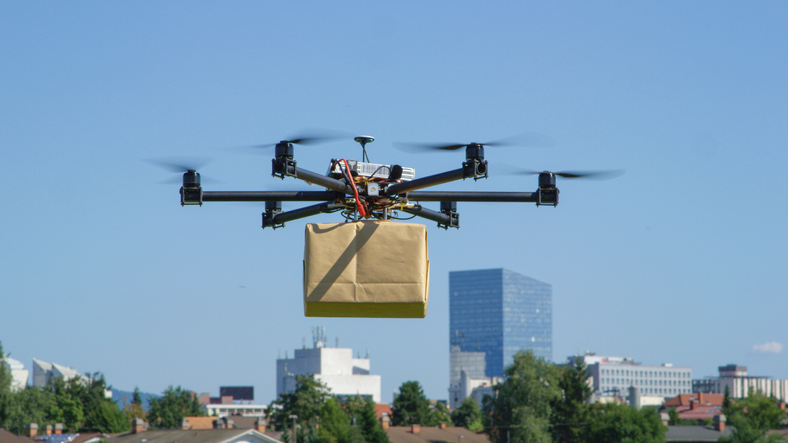Automated Vehicle and Drone Delivery Are on the Horizon

Editor’s note: This is the ninth in a series of 10 articles about advanced technologies and what they mean to procurement. Articles run on the second and fourth Tuesdays of the month in Inside Supply Management® Weekly, Institute for Supply Management®’s (ISM®) e-newsletter.
***
Consumers spent the coronavirus pandemic ordering online, putting an emphasis on how last-mile delivery, the final leg of the supply chain, plays a crucial role in ensuring timely and efficient delivery of goods to customers.
To meet the growing demands of e-commerce and improve delivery speed, the logistics industry is exploring such advanced technologies as autonomous vehicles (AVs) and drones. These have the potential to revolutionize last-mile logistics by offering faster, more flexible and cost-effective delivery solutions.
AVs, including self-driving cars and delivery robots, can navigate the roads autonomously, reducing the need for human drivers and offering potential cost savings.
In last-mile delivery, AVs can optimize routes, reduce delivery times and enhance delivery efficiency. With real-time tracking and sensor technologies, these vehicles can ensure secure and accurate deliveries, while also reducing carbon emissions and traffic congestion. AVs can be particularly valuable for urban areas with high delivery volumes and complex traffic conditions.
Drones, also known as unmanned aerial vehicles (UAVs), have the potential to revolutionize last-mile delivery by offering unparalleled speed and agility. Drones can bypass traffic congestion and deliver packages directly to customers' doorsteps, particularly in remote or hard-to-reach areas. With advancements in drone technology, such as increased payload capacities and longer flight durations, they can handle a wider range of goods.
Additionally, drones equipped with advanced sensors and computer vision capabilities can ensure precise delivery and avoid obstacles. However, regulations and airspace management are key considerations for widespread drone adoption in last-mile delivery.
Capitalizing on the Benefits
Let’s look more closely at the benefits that AVs and drones provide.
Enhanced delivery speed. These technologies can significantly reduce delivery times by leveraging optimized routes and avoiding traffic congestion. This allows for faster and more efficient deliveries, improving customer satisfaction and meeting the growing expectations of same-day or even same-hour delivery.
Cost efficiency. By reducing reliance on human labor, AVs and drones can potentially lower delivery costs. AVs can operate around the clock, optimizing resource utilization and reducing overall operational expenses.
Flexibility and scalability. AVs can be deployed quickly to handle peak periods or serve remote areas where it can be challenging or time-consuming to use traditional delivery methods may be challenging or time-consuming.
Environmental benefits. With reduced fuel consumption and optimized routes, AVs and drones contribute to lower carbon emissions, promoting environmentally friendly last-mile delivery solutions.
Keeping Challenges in Mind
Despite the potential significant benefits, organizations need to address such considerations as:
Regulatory and legal frameworks. Comprehensive regulations and guidelines are essential to ensure safe and responsible operation of AVs and drones. These need to address concerns related to privacy, airspace management and public safety.
Infrastructure requirements. Deploying AVs and establishing drone delivery networks require adequate infrastructure, including charging stations, landing pads and communication networks. Infrastructure development must align with the unique requirements of these technologies.
Technology reliability. AVs and drones must demonstrate consistent and reliable performance in various weather conditions, traffic scenarios and geographies. Continued advancements in technology and rigorous testing are necessary to build trust and confidence in their capabilities.
Customer acceptance. This is crucial to the success of deliveries by these technologies. Ensuring transparency, addressing privacy concerns and effectively communicating the benefits to customers are critical to gaining trust and support.
Autonomous vehicles and drones hold immense potential to revolutionize last-mile delivery operations. With their ability to improve delivery speed, enhance cost efficiency, and provide flexibility, these technologies offer exciting possibilities for the logistics industry. However, addressing regulatory challenges, investing in infrastructure, ensuring technology reliability and gaining customer acceptance are crucial steps to unlock their full potential.
As these technologies continue to evolve, organizations can expect a transformative impact on the speed, efficiency and convenience of last-mile logistics, ultimately redefining the customer experience in the delivery ecosystem.


